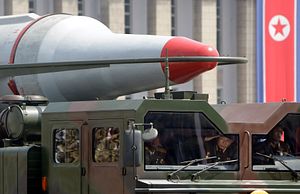Despite North Korea’s increasing isolation from its only strategic ally and benefactor, China, it has remained resolute in its antagonistic stance against the U.S. in recent weeks, especially as South Korea and the U.S. conduct regular military drills in the region. North Korea has responded by increasing its tempo of missile launches, and on Wednesday it was revealed that Pyongyang could be preparing for a full intercontinental ballistic missile (ICBM) test. The U.S. has responded with new and proposed sanctions on several fronts as it seeks to constrain the Hermit Kingdom’s behavior.
However, any actual U.S. levers over North Korea’s behavior are limited, and many in the West, including some top American officials, are becoming sensitized to Pyongyang’s repeated nuclear and ballistic missile tests. As North Korea shows that it is not only unresponsive to sanctions, despite the cost to its economy and population, but that it can make steady progress in its missile and nuclear research, the U.S. and its allies will have to find more creative ways to check its progress before it manages to miniaturize a nuclear device and successfully mount it to a fully operational ICBM.
Following a rather audacious threat on Sunday from Pyongyang to strike the U.S. with nuclear weapons, on the 61st anniversary of the Korean War Armistice, it does appear that the military regime is taking steps to be able to do just that. Satellite imagery from the U.S.-Korea Institute at Johns Hopkins University’s 38 North blog suggests that ICBM engine trials may be coming to a close. If those trials are successfully concluded by the end of this year, “the next stage in development of the KN-08 road-mobile ICBM may be a full-scale flight test of the missile.” Modifications to the Sohae Satellite Launching Station in order to accommodate such a large missile could be ready by 2015, although there is considerable speculation in the intelligence community as to whether North Korea is making enough progress in its ballistic missile program to be ready by such an early date.
On Wednesday, the same day 38 North published its findings, the U.S. special representative for North Korea policy, Glyn Davies, said North Korea would not give up its nuclear and missile programs unless the international community maintained its sanctions regime. He said the U.S. would continue to cooperate with the U.N. and on its own to “strengthen and bolster the existing sanctions regime.” In that vein, the U.S. Treasury Department on Wednesday sanctioned two North Korean shipping firms involved in transporting missiles and aircraft between Pyongyang and Cuba last year.
On Tuesday U.S. Admiral Samuel Locklear told reporters at the Pentagon he was concerned that the frequency of North Korean missile tests was increasing this year, and that the international community was becoming “somewhat numb” to them. He also said he believes Pyongyang’s missile program is making “steady progress,” and that if North Korea is willing to go through with its tests despite being warned not to, the international community has to assume the North is making progress with its technology.
The U.S. House of Representatives has also passed another round of sanctionsthat it says will be as effective as the banking restrictions imposed in 2005 that effectively shut North Korea out of the international banking community. The new sanctions are intended to target “institutions controlled by Kim Jong-un.” The authors of the House bill expect it to pass when it reaches the Senate, further ratcheting up economic pressure on the Kim regime.
Despite the effectiveness of the 2005 sanctions in dramatically limiting the North Korean regime’s access to hard currency, it did not force Pyongyang to abandon its weapons programs. North Korea’s leadership has repeatedly displayed its willingness to allow the country to undergo deep economic pain in order to maintain its grip on power. China, which has the most leverage over North Korea, has not managed to bring the new regime under Kim Jong-un in line, despite reports that it has vastly curtailed economic support and energy exports.
Despite North Korea’s penchant to go overboard in its threats to destroy both the U.S. and South Korea, it is usually very calculated in how and when it displays its military capabilities. It has yet to go beyond espionage and limited tactical engagements with South Korea. However, it has also shown no signs of giving up on its nuclear and ballistic weapons programs, and while their threat to the continental U.S. is not imminent, the U.S. has also not found a policy that can induce North Korea to give them up. Given the current trajectory of events, the U.S. must increasingly plan for a day when that threat is real. What its policy will be at that point remains up for debate.
































